Everybody comes across composites in his/her daily life. You might have a "carbon
bike" (all professional cyclists are using one), you might be playing tennis or badminton with a
"graphite racket", your bath tub might be a composite material, your skis are made of composite,
several parts of your car body are made of composite,... You can read much
more about this in the section
composites in daily life.
In industry, the market share of composites is even increasing much faster, and composites are now
widely used in aerospace industry, automotive industry, marine industry,...
Unfortunately, composite materials are not very well known to the broad public. Yet, the first step
towards working with composites is very small, and with only very limited equipment, you can already
create very nice composite components.
Composites or composite materials are a combination of two or more materials,
in such a way that you can still distinguish the separate material phases after manufacturing.
In most cases, the term "composite" or "composite material" refers to
fibre-reinforced plastics, because this is by far the most important category of composite
materials. In these fibre-reinforced plastics, the plastic is reinforced with fibres to make a
light and strong material. The material in which the fibres are embedded, is called the
matrix, while the fibres are called the reinforcement.
Beside the fibre-reinforced plastics, there are a wide variety of composite materials: metal
matrices with metal fibres, ceramic matrices with metal or ceramic fibres, etc. Even steel reinforced
concrete could be classified as a composite, although it is rarely considered to be part of the
composites family.
The matrix can basically be any type of plastic: epoxy, polyester, vinylester,
polypropylene (PP),... There is a big difference between
thermosetting and thermoplastic
resins for composites.
Thermoset polymers are the matrix of choice for most structural
composite materials. The single biggest advantage of thermoset polymers
is that they have a very low viscosity and can thus be introduced into
fibres at low pressures. Impregnation of the fibres is followed by
chemical curing to give a solid structure, which can usually be carried
out isothermally. As the thermoset cannot be re-melted again,
recycling of thermoset composites is difficult. They can only be ground
and used as filler, a process which decreases the value
of the composite enormously.
Thermoplastic polymers tend
to have melt viscosities between 500 and 1000 times that of thermosets,
which necessitates higher pressures, causes processing difficulties and
adds expense. On the other hand, an advantage of thermoplastics is that
the moulding can be carried
out non-isothermally, i.e. a hot melt into a cold mould, in order to
achieve fast cycle times. Thermoplastic composite polymers can also be
readily recycled,
an increasingly important issue in many markets, but especially in
the automotive sector.
Summarized, over 90% of polymers used
in composites are thermosets, with thermoplastic composites still
a niche market, mainly due to the difficulties in processing.
|
Thermosetting resins |
Thermoplastic resins |
|
epoxy |
polypropylene (PP) |
|
unsaturated polyester (UP) |
thermoplastic polyesters (PET, PBT) |
|
vinylester |
polyether sulphide (PES) |
|
polyurethane (PUR) |
polyphenylene sulphide (PPS) |
|
phenolic resin |
polyether imide (PEI) |
|
acrylic resin |
polyether ether ketone (PEEK) |
The fibres are typically glass, carbon (graphite) or aramid
(trade name Kevlar). The fibre reinforcement can take any form: a mat of short chopped fibres,
a woven fabric, a unidirectional arrangement of fibres, a braid, a knit,...
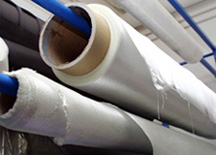 |
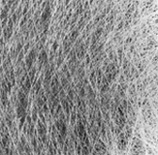 |
 |
|
Glass fabrics |
Glass mat |
Plain weave glass fabric |
If you look on the microscopic scale, you can still distinguish the individual
fibre filaments in the plastic matrix.
 |
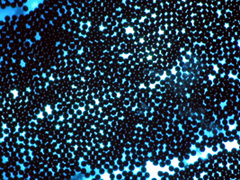 |
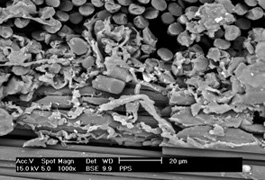 |
|
Microscopic cross-section of plain weave fabric |
Individual carbon fibre filaments in epoxy matrix |
Individual carbon fibre filaments in a polyphenylene sulphide (PPS) matrix |
One of the big advantages of fibre-reinforced composites
is that the stiffness and strength can be tailored to the specific loading
conditions. If the loading of the composite component will be dominantly
oriented in one direction, you can apply the fibre reinforcement mainly
in that direction. This makes the composite anisotropic. It means
that its stiffness and strength are not the same in every direction, but
can differ for every direction in the material.
This anisotropy is exploited deliberately in designing with composites as follows.
You start with one single ply of fibre-reinforced plastic. This building
block is called the lamina, layer or ply. Suppose that all reinforcing fibres
are oriented in the same direction, referred to as the 0° direction. This
individual ply is already strongly anisotropic, because the stiffness
and strength properties are much higher in the fibre direction than
transverse to the fibres. Now you can tailor the stiffness and strength in different
directions by stacking additional layers under different orientation angles.
The resulting pile of plies is called the laminate, built up of individual
laminae. The stacking sequence or lay-up refers to the symbolic
notation of the sequence of orientation angles. The stacking sequence for the
laminate shown below is [0°/+45°/-45°/90°/90°/-45°
/+45°/0°], but because the lay-up is symmetric with respect to
the midplane, the standard notation is [0°/+45°/-45°/90°]s, where
the subscript "s" stands for "symmetric".
Of course, our building block - the individual lamina - can be reinforced
with any type of fibre architecture (mats, weaves, braids, knits, etc.).
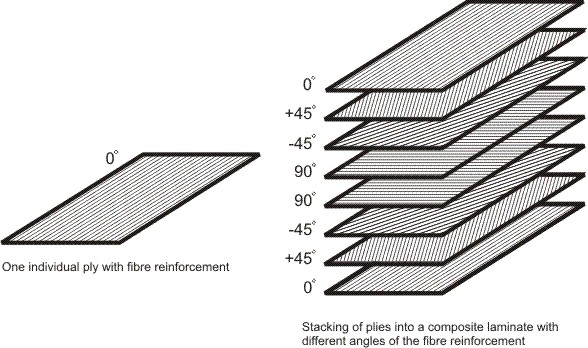 |
|
Stacking sequence of a composite laminate |
A special type of composite laminate is the sandwich composite,
where some of the middle layers of the laminate are replaced by a very
lightweight core material, typically being foam, balsa wood or metallic
honeycombs. The typical sandwich structure is shown below. The parts B are called
the skins or facing sheets, while part C is called the core (in this case a honeycomb
core). The right picture shows a realization of such a sandwich composite.
Sandwich composites are very attractive because they are very lightweight structures
with a very high bending stiffness and usually good impact and fatigue resistance. They can
be found in ship hulls, floor panels, architectural claddings, etc.
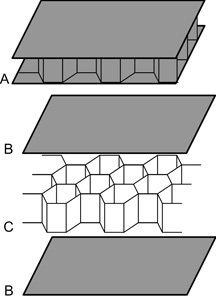 |
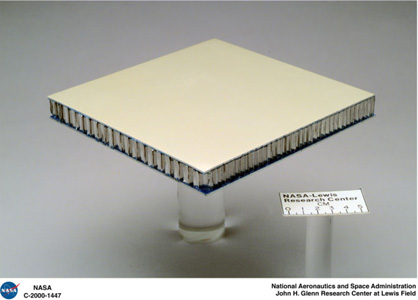 |
|
Typical sandwich structures |
Sandwich panel developed by NASA |
So far, we only discussed flat, planar composite plates. Of course, the power
of composites just lies in the fact that complicated parts can be made with
complex shaped geometries and reduced number of joints. To achieve this,
a lot of manufacturing processes are at hand. More information can be found
in the section Organizing your
composite workshop.
|









